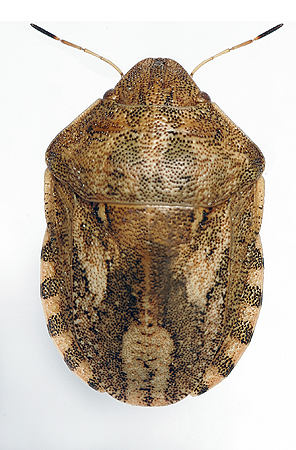Pests
Eurygaster maura Linnaeus - Sunn Pest
Systematic position.
Class Insecta, order Hemiptera, family Scutelleridae, genus Eurygaster.Biological group.
Oligophagous pests of cereals.Morphology and biology.
The ovoid body of imago is light brown. Its length varies from 7 to 11 mm. Wide triangular head is bent. Easily visible tylus is limited by lamellae on cheeks. Lateral borders are straight (this is a difference from Eurygaster integriceps Put.). Wide scutum rounded at apex, covering wing and abdomen. There are black spots on abdominal segments. At first, larva has lemon color and spherical form, then becomes dark and wingless. Light green eggs are also spherical, length about 1 mm. The overwintering takes place at the imago stage under fallen leaves in forests. Awakening is only observed at the end of April at temperature 18-19°C (later than that in E. integriceps). Additional feeding is necessary; the bugs usually populate perennial cereal grasses, being able to do considerable migrations. The insect leaves openly. Coupling takes place in May, and oviposition at the beginning of June. The period from awakening to coupling lasts about a month. Bugs lay the eggs by regular rows (by 10-14 in a row) into the drop of excretion on lower side of leaves or stems. Fecundity of one female varies from 24 to 29 eggs (1.5 times less than that in E. integriceps). Embryonal development lasts 12-14 days. Insect has five larval instars. The first instar larvae do not move on plant, locating among scales of ears; older instar larvae crawl on plants, looking for food. Larvae and young bugs feed on grains. Larval stage lasts about one month. The bugs fly at the middle of July and migrate to forests at the beginning of August. The insects fly during September and October. This species is marked on fields usually at a small number, but sometimes at a big number.Distribution.
The insect is distributed widely in Europe, Anterior and Middle Asia, North Africa. Within the territory of the Former Soviet Union the species occurs widely northward to Byelorussia, Smolensk, Moscow, Nizhnii Novgorod, Ryazan' Regions, Tatarstan. The species is known from Ukraine, Kazakhstan, Moldova, Transcaucasia, and Bashkortostan. Within the territory of Russia, the largest pest numbers are observed in Krasnodar, Stavropol', Caspian Basin regions. In Siberia and Primorskii Territory, the species has not been recorded. Its high harmful activity appears in the southern part of forest zone and in forest-steppe zone.Ecology.
This species is xerophilous, active at the temperatures 18-19°C. Insects essentially perish during cold damp winters with light snow covering. In spring, awakening bugs endure frequent changes of temperature and abundant precipitations. The most favorable conditions are the temperatures 24-26°C and relative humidity 60-80%. The insect endures the temperatures from 9 to 35°C without diapause. The pest willingly populates dense crops (with high humidity). Bugs prefer feeding on perennial cereal grasses; during the driest years it sometimes migrates actively on crops where the number of pests increases considerably. Species gives 1 generation a year. Most important predators are Microphanurus vassilievi Mayr., M. cultratus Mayr., Cystogaster globosa Fln., Helomyia lateralis Meig., Cylindromyia auriceps Meig., C. intermedia Meig., Rhodogune rotundatum L.Economic significance.
The insect usually feeds on perennial cereal grasses, also on wheat, rye, barley, oats, maize, millet. Leaves become yellow, dry up, and the plant lags in its growth. Larvae and bugs feed on ears. The ears have small grains. The grains become puny, lose their qualities. The species is not as dangerous as E. integriceps because its awaking is marked later and its fecundity is not high. Control measures include eradication of weeds, early harvesting of grain, under-winter plowing, insecticide treatments against both adults and larvae when exceeding economic threshold numbers.Reference citations:
Arkhangel'skii N.N. 1946. Materials to studying factors regulating bugs number of the genera Eurygaster. In: Zakharov S.A., ed. Proceedings of Rostov State University. Rostov on Don: State University. P. 37-38 (in Russian).Bei-Bienko N.G. 1969. Some features and the numbers of two bug species (Eurygaster). Zoologicheskii zhurnal 48(6): 836-840 (in Russian).
Mokrzhetskii S.A. 1894. Sunn pest in Crimea. Simpheropol': Spiro. 68 p. (in Russian).
Pavlov A.N. 1954. Damaging grains by sunn pests (Eurygaster, Pentatomidae) at the irrigation conditions. In: Oparin A.I., ed. Reports of Academy of Sciences of USSR, 98(4). Kiev: AN UkrSSR. P. 661-663 (in Russian).
Pogorelov M.N. 1965. Dynamics of development and species composition of cereal bugs in the eastern zone of Khar'kov region in 1964. In: Grinchenko A.M., ed. Proceedings of Khar'kov agricultural institute, N 6. Khar'kov: Agricultural Institute. P. 11 (in Russian).
Puchkov V.G. 1972. Order Hemiptera - bugs. In: Kryzhanovskii O.L., ed. Insects and mites - pests of agricultural cultures. V. 1. Leningrad: Nauka. P. 225-226 (on Russian).
Sokolova N.N. 1901. Sunn pest. In: Insects and others animals - pests of agricultural crops. V. 3. St.Petersburg: Marks. 84 p. (in Russian).
Taranukha M.D. 1952. Cereal bugs in forests and forest strips. In: Pogrebnyak P.S., ed. Proceedings of Academy of Sciences of UkrSSR, N 4. Kiev: AN UkrSSR. P. 67-79 (in Russian).
Taranukha M.D. 1954. To ecology of cereal bugs of the genus Eurygaster. In: Markevich A. P., ed. Proceedings of Kiev State University. Kiev: State University. Part 1. P. 260-261 (in Russian).
Vasil.ev V.P., ed. 1973. Pests of agricultural crops and forest plantations. Vol. 1. Kiev: Urozhai. p.348-350 (in Russian).
Zabarinskii L.A. 1893. Sunn pest. In: Entomological investigations and excursions. Odessa: Khrisogelos. 13 p. (in Russian).


